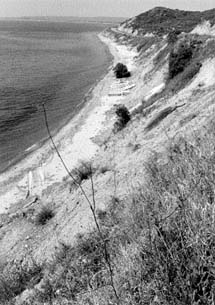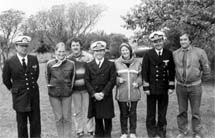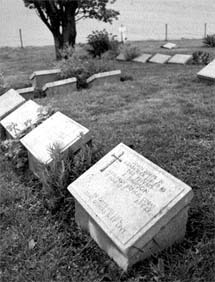Anzac Cove
revisited
Chris Rothery and Kate Young made the
pilgrimage
to Gallipoli to see first hand what our diggers faced.
Here are Chris's recollections ...
When the dawn broke, it was very, very
still. The drizzling rain meant we could not see a thing as we bounced
along the little track down to ANZAC Cove. We had arrived before the
dawn and then got out and made our way down to the beach.
I suppose it just happened, there wasn't an action plan. It was just
one of these things. We had all moved down, there was no laughing or
talking; it was really quiet and it was almost like a religious experience.
Down on the beach, very very still then the drizzle stopped as the dawn
came up and we started to see the silhouette of what the ANZACS must
have seen as they came ashore.
All of a sudden the penny dropped -God, this is what it was like. No
wonder they were slaughtered! The sheer cliff faces and the very unforgiving
terrain, the fact that you were looking up there and the Turks had their
defenses and they were looking down on you and you were just sitting
ducks. It was an awesome experience.
We didn't have a formalised ceremony as such, there were only the twelve
of us, there was no one else there, this was in 1984. Some of us just
stood there quietly, one or two others said the ode to themselves and
it was a very religious experience.
After that, when the dawn had come up and we could see the terrain we
walked along the beach and you were still able to pick up old shells
and cases and stuff like that, even after such a long time. Then we
made our way up to the first grave area and we came upon Simpson's grave.
Simpson and his donkey, which had seemed so profound in my Primary School,
and probably in every other Australian's Primary School, and here we
were actually seeing his grave where he was buried.
We spent the next while looking around and exploring and then we made
our way back to Eceabat. When we got back, we came across the official
party from Eceabat who were going to make the official wreath laying
ceremonies.
The Turkish people were running it this year and when they found that
we were Australians, that we'd come from so far away, the Turkish captain
immediately asked us four Australians to join him as his official guests
and be taken around and be part of the ceremony. Of course we jumped
at that and they were extremely hospitable people.
They talked with great respect about Australia and Australians and about
how they felt about Australians. They took great pride in the fact that
the War Graves Commission, although it's an Australian thing, looks
after the War graves very well.
The other thing that struck us, as we moved from one War grave site
to another was the tranquillity of the whole peninsula. It is hard to
visualise that there had been so much carnage and so much killing and
so much sickness. It had a very park-like tranquillity, which is in
stark contrast to what it was all those years ago.
It wasn't called Anzac Cove for a long time, it's only officially been
called Anzac Cove since 1985. The Turkish Government renamed the Cove
and they put a great big plaque up there. The inscription is a magnificent
thing for this was an inscription based on the writings of Mustafa Kemal
Atatürk.
He was originally an army officer at Gallipoli and helped organise the
defenses against the Anzacs, but he later went on to become the father
of modern Turkey. He wrote about the Anzacs and this is what is inscribed
on the Anzac Cove Memorial, at Anzac Cove. (See below)
You know, for a country to acknowledge the bravery and also the sacrifice
that its enemy has made is a wonderful thing, and to acknowledge it
in such a large monument once again shows the high standing the Turkish
people hold for Australians in particular.
Yes, I thought it was a nice inscription.
Those heroes that shed their blood
And lost their lives ...
You are now lying in the soil of a friendly country.
Therefore rest in peace.
There is no difference between the Johnnys
And the Mehmets to us where they lie side by side.
Here in this country of ours ...
You, the mothers who sent their sons from faraway
countries,
Wipe away your tears;
Your sons are now lying in our bosom
And are in peace.
After having lost their lives on this land,
They have become our sons as well.


Chris Rothery (On
the right) and Kate Young (second from the left) with part of the group
who visited ANZAC Cove in 1984, with their Turkish host.

Simpson's grave.